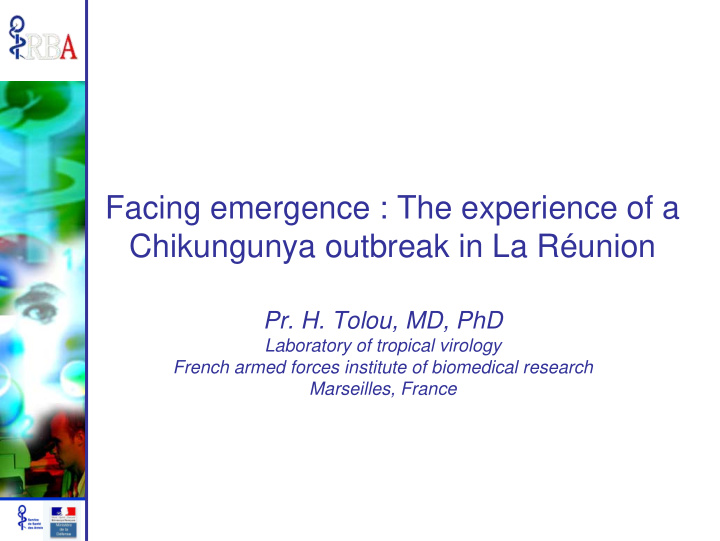



Facing emergence : The experience of a Chikungunya outbreak in La Réunion Pr. H. Tolou, MD, PhD Laboratory of tropical virology French armed forces institute of biomedical research Marseilles, France
Epidemics can have different origins : • Known endemic agent • Known imported agent • Unknown or unsuspected endemic agent • Unknown agent of unknown origin, either natural or modified
Emergence poses several problems : • To recognize the agent or the disease as a new one • To identify the new agent • To make rapidly available diagnostic tools • To identify the origin and routes of transmission of the agent • To prevent and treat infections
The story of an epidemic (1) • Before 2004, CHIKV was known only in Africa and South-east Asia • In late 2004, CHIKV infections are detected in Comoros • One case is imported and diagnosed in Marseilles, as the result of systematic screening of tropical infectious diseases in military and civilian travellers
The story of an epidemic (2) • Due to the alert and specific procedures, several cases can be diagnosed in La Réunion Island, but diagnostic tools are not available locally • An epidemic begins in 2005 and develops until mid 2006 (250 000 persons became infected) • Many people come back infected to France and to other northern countries
Contribution of SSA (1) • SSA vector control teams are sent to La Réunion Island • An epidemiologist with experience of large tropical and vector-borne outbreaks is sent to help local authorities • The laboratory of tropical virology in Marseilles acts as a public-health laboratory, providing diagnosis, diagnostic tools and expertise : � First, samples for diagnostic are sent to France � Rapidly, molecular biology and serology techniques and reagents are transferred to local laboratories
Contribution of SSA (2) • Available knowledge on CHIKV infection is shared with physicians and health authorities: duration of incubation, asymptomatic infections rate, routes of transmission CHIKV infection clinical course IgG IgM 1 4 11 Jours/Mois
Contribution of SSA (3) • While blood and cornea collection are suspended, virological control for organs transplantation is done in Marseilles • In a second phase, research is carried out looking at the origin of the virus (genome sequencing and phylogeny), its vectors and reservoir
Contribution of SSA (4) • As the epidemic develops and travellers come back to France, diagnostic reagents are produced and distributed to all national laboratories • Investigations are done on late, post-acute, evolution of the disease both in military and civilian patients • In the post-epidemic period, our laboratory is part of the national plan for surveillance and control of imported CHIKV infections in South France where Ae. albopictus is now present : � Virological diagnosis of suspected cases � Investigations on potential vectors (virus detection)
The lessons of the outbreak (1) • Emergence can take on many worrying aspects • Although CHIKV was not totally unknown, basic knowledge and tools were lacking • Previous experience we have had with CHIKV in Africa proved very useful and valuable • Systematic and large investigations done on “sentinel” population (travellers) is an important issue
The lessons of the outbreak (2) • Interest must be attached to every agent with potential to affect Humans, everywhere • Basic epidemiological, biological and clinical knowledges must be acquired and updated • Diagnostic tools must be developed and made available
Recommend
More recommend